List of World Heritage Sites in Switzerland facts for kids
Have you ever heard of a World Heritage Site? These are special places around the world that are important for everyone to protect. They can be amazing natural wonders or incredible human-made structures. The United Nations Educational, Scientific and Cultural Organization decides which places get this special title.
Switzerland joined the World Heritage Convention in 1975. This meant its unique natural and cultural spots could be added to the list. As of 2021, Switzerland has 13 World Heritage Sites. Nine of these are cultural sites, like old cities or buildings. Four are natural sites, like mountains or forests.
The first three sites were added in 1983: the Old City of Berne, the Abbey of Saint Gall, and the Benedictine Abbey of St. John at Müstair. The newest additions were two forests in 2021. These forests became part of a larger site called the Ancient and Primeval Beech Forests of the Carpathians and Other Regions of Europe.
Some of Switzerland's sites are shared with other countries. For example, the Rhaetian Railway and Monte San Giorgio are shared with Italy. The Prehistoric pile dwellings around the Alps are shared with five other countries. The amazing buildings by The Architectural Work of Le Corbusier are shared with six countries. And the Ancient and Primeval Beech Forests are shared with 17 countries! Switzerland also has one site on a "tentative list," meaning it might be nominated in the future.
Contents
Amazing World Heritage Sites in Switzerland
UNESCO picks sites based on ten different rules. Some rules are for cultural sites, and others are for natural sites. * Transnational site
| Site Name | Picture | Location (Canton) | Year Listed | Type | What Makes It Special |
|---|---|---|---|---|---|
| Old City of Berne | 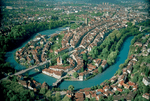 |
Bern | 1983 | Cultural | Berne was built in the 12th century on a hill, surrounded by the Aare River. It grew in a very planned way, keeping its old charm. In the 16th century, fountains were added, and in the 18th century, older buildings were updated. |
| Convent of St Gall |  |
St. Gallen | 1983 | Cultural | This old monastery was built in the 8th century. It was one of Europe's most important monasteries. Its library is super old and has many valuable handwritten books, like the Plan of Saint Gall. Some parts were rebuilt in the fancy Baroque style in the 18th century. |
| Benedictine Convent of St John at Müstair | 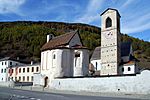 |
Grisons | 1983 | Cultural | The Convent of Müstair is a Christian monastery from the Carolingian period, started around 775. Its church has Switzerland's best collection of old wall paintings from the early 9th century. Some paintings were covered but later brought back to life in the 20th century. Since the 12th century, it has been a religious center for Benedictine nuns. |
| Three Castles, Defensive Wall and Ramparts of Bellinzona | 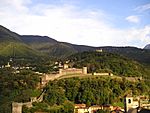 |
Ticino | 2000 | Cultural | The forts at Bellinzona protected the way into the Ticino valley. This valley was a key route to one of the most important mountain passes into northern Italy. Most of the forts were built in the 15th century, but some parts are even older. There are two castles, Castelgrande and Montebello, linked by walls. A third castle, Sasso Corbaro, sits on its own rocky spot. They are all very well preserved. |
| Swiss Alps Jungfrau-Aletsch |  |
Bern and Valais | 2001 | Natural | This area has some of the highest and most icy parts of the Alps, with famous peaks like Eiger, Mönch, and Jungfrau. It shows how the High Alps were formed by glaciers. It's also home to many different animals and plants that grow as glaciers melt away. This landscape has been very important for mountain climbing and tourism, and it has inspired many artists and writers. The site was first listed in 2001 and made bigger in 2007. |
| Monte San Giorgio* | 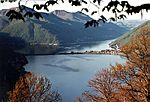 |
Ticino | 2003 | Natural | Monte San Giorgio, near Lake Lugano, has the best collection of fossils from ocean life during the Triassic Period (245–230 million years ago). Back then, this area was a warm lagoon full of sea creatures like reptiles, fish, and shellfish. Fossils of land animals are also found here because the lagoon was close to land. The Swiss part of the site was listed in 2003, and the Italian part was added in 2010. |
| Lavaux, Vineyard Terraces | 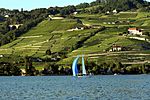 |
Vaud | 2007 | Cultural | The vineyard terraces at Lavaux stretch for about 30 kilometers (19 miles) along the sunny northern shores of Lake Geneva. They go from Chillon Castle to the edge of Lausanne. These terraces date back to the 11th century, when monks managed the area. Wine has been very important for the local people for hundreds of years. The protected area includes villages, old buildings, roads, and walking paths. |
| Rhaetian Railway in the Albula / Bernina Landscapes* | 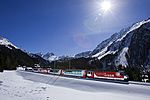 |
Grisons | 2008 | Cultural | The Albula and Bernina lines of the Rhaetian Railway are two old train lines that cross the Swiss Alps. They were built in the early 1900s, making it easy and fast to reach many mountain villages that used to be hard to get to. Building these railways was a huge challenge, needing many bridges, tunnels, and galleries. This site is shared with Italy. |
| Swiss Tectonic Arena Sardona | 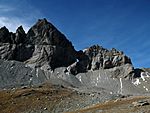 |
Grisons, Glarus, St. Gallen | 2008 | Natural | The Glarus Alps show a major thrust fault. This is a cool geological event where older rocks are pushed over younger rocks when mountains are formed. Because this area is easy to visit, it has been very important for studying how Earth's crust moves and how mountains are built since the 18th century. |
| La Chaux-de-Fonds / Le Locle, Watchmaking Town Planning | 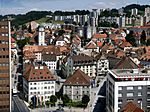 |
Neuchâtel | 2009 | Cultural | These two towns are in the remote Swiss Jura Mountains. Since the land wasn't great for farming, the towns focused on making watches. After big fires in the 1800s, both towns were rebuilt to support this watchmaking industry. What started as small home workshops grew into big factories in the late 19th and 20th centuries. The town of La Chaux-de-Fonds was even studied by Karl Marx in his famous book Das Kapital because of its watchmaking setup. |
| Prehistoric pile dwellings around the Alps* | 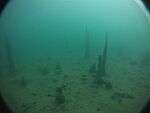 |
56 locations | 2011 | Cultural | This site is shared with Austria, France, Germany, Italy, and Slovenia. It includes 111 small places where people lived in pile-dwelling settlements. These homes were built from about 5000 to 500 BCE on the edges of lakes, rivers, or wetlands. They give us a lot of information about how people lived and traded in the Stone Age and Bronze Age in the Alps. Fifty-six of these sites are in Switzerland. |
| The Architectural Work of Le Corbusier, an Outstanding Contribution to the Modern Movement* | 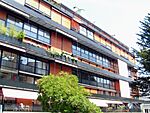 |
Vaud, Geneva | 2016 | Cultural | This site is shared with Argentina, Belgium, France, Germany, India, and Japan. It includes 17 buildings designed by the famous Franco-Swiss architect Le Corbusier. Le Corbusier was a key figure in the Modernist movement. He created new ways of building to fit the needs of a changing society. Two of his buildings on the list are in Switzerland: Immeuble Clarté and Villa Le Lac. |
| Ancient and Primeval Beech Forests of the Carpathians and Other Regions of Europe* | Ticino, Solothurn | 2017 | Natural | These ancient forests are used to study how the beech tree (Fagus sylvatica) spread across the Northern Hemisphere in different environments. The site was first listed in 2007 in Slovakia and Ukraine. It was expanded in 2011, 2017, and 2021 to include forests in 18 countries. Two forests in Switzerland were added in 2021: Forêt de la Vallée de Lodano and Forêt de la Bettlachstock. |
Future World Heritage Sites: The Tentative List
Besides the sites already on the World Heritage list, countries can also keep a list of "tentative" sites. These are places they might want to nominate in the future. A site must be on this tentative list before it can be officially nominated for the World Heritage list. As of 2021, Switzerland has one site on its tentative list.
| Site Name | Picture | Location (Canton) | Year Listed | Type | What Makes It Special |
|---|---|---|---|---|---|
| Salginatobel Bridge |  |
Grisons | 2017 | Cultural | This reinforced concrete bridge is 132 meters (433 feet) long and crosses 93 meters (305 feet) over the Salgina gorge. It was designed by Swiss engineer Robert Maillart and finished in 1930. The bridge is famous for its smart use of new materials and its elegant design. |
See Also
 In Spanish: Anexo:Patrimonio de la Humanidad en Suiza para niños
In Spanish: Anexo:Patrimonio de la Humanidad en Suiza para niños
- List of Intangible Cultural Heritage elements in Switzerland
- Swiss Inventory of Cultural Property of National and Regional Significance
- Lists of tourist attractions in Switzerland

